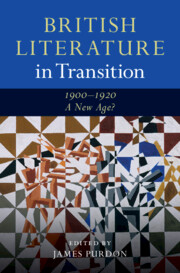Book contents
- British Literature in Transition, 1900–1920: A New Age?
- British Literature in Transition Series
- British Literature in Transition, 1900–1920: A New Age?
- Copyright page
- Contents
- Contributors
- General Editor’s Preface
- Acknowledgements
- Introduction
- Part I Nation and Empire
- Part II Media
- Chapter 7 Literature and Wartime Propaganda
- Chapter 8 Black, White, and Read All Over
- Chapter 9 Notable Trials and Literary Realism
- Chapter 10 Literature and Telecommunication
- Chapter 11 Literature and Film
- Part III Aesthetics
- Part IV Society
- Index
Chapter 10 - Literature and Telecommunication
from Part II - Media
Published online by Cambridge University Press: 07 December 2021
- British Literature in Transition, 1900–1920: A New Age?
- British Literature in Transition Series
- British Literature in Transition, 1900–1920: A New Age?
- Copyright page
- Contents
- Contributors
- General Editor’s Preface
- Acknowledgements
- Introduction
- Part I Nation and Empire
- Part II Media
- Chapter 7 Literature and Wartime Propaganda
- Chapter 8 Black, White, and Read All Over
- Chapter 9 Notable Trials and Literary Realism
- Chapter 10 Literature and Telecommunication
- Chapter 11 Literature and Film
- Part III Aesthetics
- Part IV Society
- Index
Summary
This chapter considers intersections between the histories of literature and of telecommunication technologies – telegraph, telephone, radio – in the first decades of the twentieth century. Early in the century, some readers might have encountered ‘Hertzian waves’ for the first time when Kipling drew on them as figures for determinism, invisible influence, and the unconscious. Technologies of telecommunication also offered a reference point for a modern sense of simultaneous connection and disconnection in the works of authors technophilic (Wells), technophobic (Forster, Eliot), or more conflicted (Ford), as well as those whose attitudes towards technology were at times even harder to parse (Joyce, Woolf). The cryptic codes of telegraphy, the decoupling of the voice from body on the wire and the airwaves, the emergent possibilities of a mass culture broadcast into the air in real time: all of these helped reshape not only the media ecology in which print works had value and meaning, but also some of the most urgent questions facing authors in the century’s opening decades, questions of the relationships between culture and subjectivity, fragmentation and totality, signal and noise.
- Type
- Chapter
- Information
- British Literature in Transition, 1900–1920: A New Age? , pp. 192 - 208Publisher: Cambridge University PressPrint publication year: 2021

